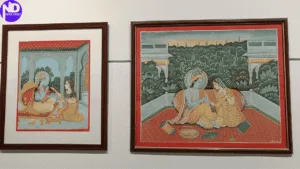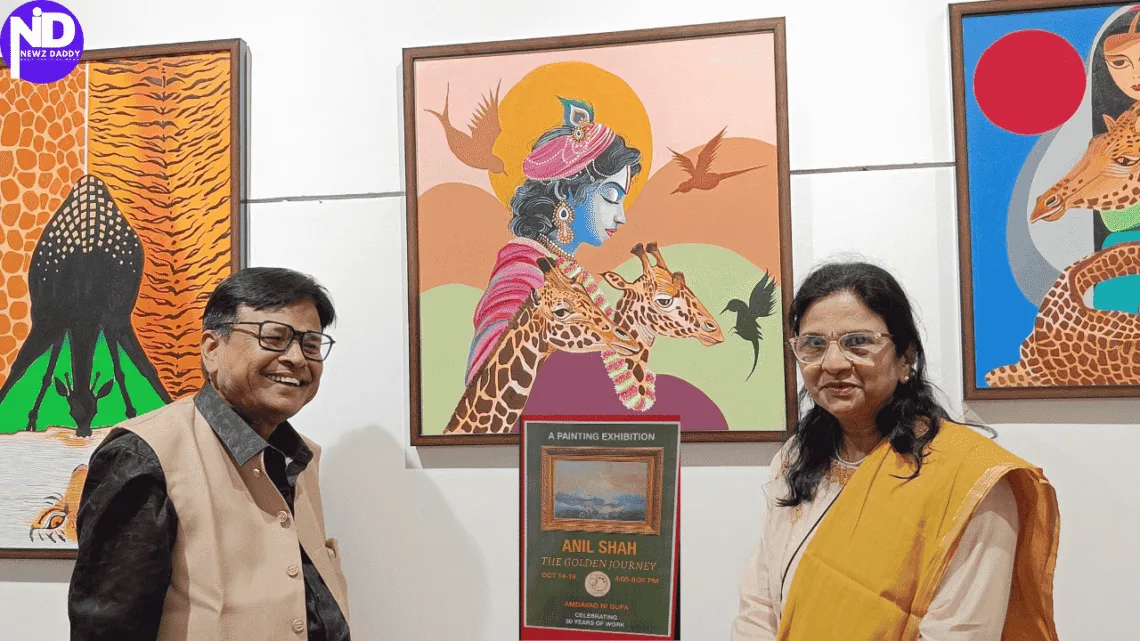Anil Shah “Golden Journey” 50 Years of Art Magic
Travel Through Time And Art At The Anil Shah “Golden Journey” Exhibition At Amdavad ni Gufa
Fifty Years of Artistic Journey
The span of fifty years is not common. A retrospective like this helps people see not just single works, but how an artist’s voice changes over time. It invites comparisons: what stayed constant, what shifted, what risks were taken. Retrospectives help younger artists, students, and the public understand the long haul of creativity.
The location itself is special. Amdavad Ni Gufa (also called Ahmedabad ni Gufa) is an underground art gallery beneath the ground. It was designed in collaboration between the well-known architect B. V. Doshi and the famous painter M. F. Husain.
Its architecture is organic: there are no straight lines. The domes are rounded; the interior columns curve like tree trunks.
The roof is covered in mosaic tiles, which both reflect light and help reduce heat.
Because much of it lies underground, it stays cooler in Ahmedabad’s heat.
In short, the venue is not just a display hall—it is art in itself.
Also Read:
Mythology Comes Alive in Nidhi Shah’s Powerful Debut Show
Art historians often talk about phases in an artist’s life: early realism, middle explorations, and mature synthesis. In this exhibition, Shah allows us to see that play.
His early works probably show more realism, more representational forms—portraits, figures, scenes, people can immediately recognise. Over time, the shapes loosen, colours become more expressive or symbolic, forms may break apart, and abstraction creeps in.
This shift is common among many artists who start with mastering skills, then search for a more personal voice.
In mixing miniatures, portraits, and bold abstract works, Shah is showing the balance he found between control and freedom.

Having poet-artist Madhav Ramanuj open the show ties poetry and visual art together. That suggests Shah sees his work not just visually, but poetically.
Arvind Vakani, BR Prajapati, and Mahendra Mistry — their presence underscores that this is not just an artist’s event but a cultural moment. It draws in visual arts bodies, journalism, and senior practitioners. It signals respect from the art world and the public sphere.
Shah’s Reflection
“When I look back … the last 50 years have just flown by.” That sentence carries weight. It shows humility, surprise, and gratitude.
Artists often don’t believe they will persist so long. To see one’s work gathered like this is akin to reading your own life story, in images.
He calls the exhibition a reflection and showcases “some of my best work.” This shows he is choosing pieces he believes represent his inner self as much as his public persona.
Opening the show to students, art lovers, and the public is important. A retrospective usually draws people who know art and those who don’t. It can teach, inspire, and open questions.
It’s a chance for younger artists to see what sustained work looks like. It’s a chance for people to see how one creative life grows.
Putting Shah’s retrospective in Amdavad Ni Gufa is meaningful. The Gufa is itself a symbol of experiment, fusion, daring form. The building challenges conventions; Shah’s work also seems to challenge boundaries.
The Gufa was built in the 1990s as an art-architecture experiment, blending underground and dome forms, inspired by nature, caves, and Jain temple mosaics.
Doshi’s and Husain’s collaboration created a space that celebrates fluidity and mystery.
Thus, Shah’s evolving art inside that space feels like a dialogue: between artist, architecture, and time.
Why Retrospectives Matter in Indian Art
In India, many artists get attention regionally or for single works. But a mid- or late-career retrospective validates sustained effort.
It helps preserve an artist’s archive, memory, and legacy. It allows critics, students, public to plot influences, departures, risks, and returns.
For the city of Ahmedabad, having such shows deepens its identity as a cultural centre.
For Shah, this moment is about looking back. But it also points ahead: maybe new work, new directions. The exhibition inspires us to ask: what comes next?
For the city, the show reinforces Ahmedabad’s role in supporting art, culture, and architecture. For the public, it reminds us that art is a stretch, a lifetime’s commitment.
Venue Timing, Access & Audience
Amdavad Ni Gufa is generally open in the evenings, from 4 p.m. to 8 p.m., except on Mondays.
Showing the exhibition in mid-October means cooler weather, pleasant evenings—better for visitors to walk in and stay longer.
It’s open to the public, so anyone curious—even those who don’t regularly visit galleries—can step in. That democratizes art.
Also Read:
Former MP, Dr. Bharatiben Shiyal inaugurated the Art Exhibition ” The Journey of Soil”






